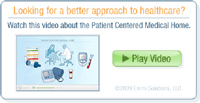 Membership
Membership
Patient Centered Medical Home (PCMH) 
- Our Patient Centered Medical Home (PCMH) membership program was founded on the principle of continuing to give you more personal choice in what level of care and services you receive and how they are delivered.
- It was intended to fill the void left by what today’s insurance products have taken away from the consumer – quality & personal choice.
- It provides you with an array of desired non-covered medical services (not paid by insurance companies - see below) and exceptional care beyond today's definition of the usual and customary.
- It involves the additional time and effort needed by your doctor, to specialize in you and your family and it is these EXTRA non-covered medical services and time that separates us from the rest in the medical community.
- It allows us to pay particular attention to your healthcare needs and give you more care and attention, to help manage many of your complex medical problems, which will allow you to be as healthy as possible, for as long as possible, at an affordable price.
- It provides the same services we used to expect from our healthcare system, which over the last 20 years, have been taken away from you. It time we got back to the basics of how things used to be.
- It offers you a more ideal and thoughtful approach to medicine
- Our goal is to always provide you with comfort, convenience and satisfaction, as well as the very best medical care.
Questions and Answers
- What is the Patient Centered Medical Home?
- What are the cornerstones of a PCMH?
- What transformations in the current system will we see?
- What are the benefits of a PCMH?
- What is the background to the PCMH?
- What is the difference between Reactive Care and Proactive Care?
- Why is access to care so important?
- What is the overall goal of the PCMH?
- What is the Patient Centered Medical Home?
A Patient-Centered Medical Home is a team-based model of care led by a personal physician who provides continuous and coordinated care throughout a patient's lifetime to maximize health outcomes. The PCMH will broaden access to primary care, while enhancing care coordination. The PCMH practice is responsible for providing for all of a patient’s health care needs or appropriately arranging care with other qualified professionals. This includes the provision of preventive services, treatment of acute and chronic illness, and assistance with end-of-life issues. It is a model of practice in which a team of health professionals, coordinated by a personal physician, works collaboratively to provide high levels of care, access and communication, care coordination and integration, and care quality and safety.
- What are the cornerstones of a patient centered medical home?
- Personal physician - each patient has an ongoing relationship with a personal physician trained to provide first contact, continuous and comprehensive care.
- Physician directed medical practice – the personal physician leads a team of individuals at the practice level who collectively take responsibility for the ongoing care of patients.
- Whole person orientation – the personal physician is responsible for providing for all the patient’s health care needs or taking responsibility for appropriately arranging care with other qualified professionals. This includes care for all stages of life; acute care; chronic care; preventive services; and end of life care.
- Care is coordinated and/or integrated across all elements of the complex health care system (e.g., subspecialty care, hospitals, home health agencies, nursing homes) and the patient’s community (e.g., family, public and private community-based services). Care is facilitated by registries, information technology, health information exchange and other means to assure that patients get the indicated care when and where they need and want it in a culturally and linguistically appropriate manner.
- Quality and safety are hallmarks of the medical home:
- Practices advocate for their patients to support the attainment of optimal, patient-centered outcomes that are defined by a care planning process driven by a compassionate, robust partnership between physicians, patients, and the patient’s family.
- Evidence-based medicine and clinical decision-support tools guide decision making
- Physicians in the practice accept accountability for continuous quality improvement through voluntary engagement in performance measurement and improvement.
- Patients actively participate in decision-making and feedback is sought to ensure patients’ expectations are being met
- Information technology is utilized appropriately to support optimal patient care, performance measurement, patient education, and enhanced communication
- Practices go through a voluntary recognition process by an appropriate non-governmental entity to demonstrate that they have the capabilities to provide patient centered services consistent with the medical home model.
- Patients and families participate in quality improvement activities at the practice level.
- What transformations in the current system will we see?
The current system cannot support the patient-centered care envisioned by the advanced medical care model and we believe that the PCMH will do the following:- It will revitalize the patient–physician relationship & place the patient and his or her family at the center of care.
- It will stimulate practice-level innovation to provide enhanced quality, effectiveness, safety, efficiency, and value because practices will be able to invest in systems-based care and measurement of that care.
- It will enhance coordination of care across all domains of the health care system (hospitals, home health agencies, nursing homes, consultants, and other components of our complex health care network).
- It will recognize that care provided by a personal physician, operating in accord with the advanced medical home model, is a highly valuable service.
- It will lead to the macro system changes required to support this enriched health care model (financing, coverage, reimbursement, physician education and training, and workforce distribution).
- What are the benefits of a PCMH?
Patient Benefits- Healthier patients and savvier health care consumers;
- Reduced costs associated with coverage; and
- Empowered patients exercising a robust relationship with their primary care providers.
Clinicians practicing in the highest level medical home will:- Take personal responsibility and accountability for the ongoing care of patients;
- Be accessible to their patients on short notice, for expanded hours, and open scheduling;
- Be able to conduct consultations through email and telephone;
- Utilize the latest health information technology and evidence-based medical approaches, as well as maintain updated electronic personal health records;
- Conduct regular check-ups with patients to identify looming health crises, and initiate treatment/prevention measures before costly, last-minute emergency procedures are required;
- Advise patients on preventive care based on environmental and genetic risk factors they face;
- Help patients make healthy lifestyle decisions; and Coordinate care, when needed
- What is the background to the PCMH?
The American Academy of Pediatrics (AAP) introduced the medical home concept in 1967, initially referring to a central location for archiving a child’s medical record. In its 2002 policy statement, the AAP expanded the medical home concept to include these operational characteristics: accessible, continuous, comprehensive, family-centered, coordinated, compassionate, and culturally effective care.
The American Academy of Family Physicians (AAFP) and the American College of Physicians (ACP) have since developed their own models for improving patient care called the “medical home” (AAFP, 2004) or “advanced medical home” (ACP, 2006).
The Medical Home Model represents a paradigm shift, where the plan’s essential role is to improve access to care and assist with coordination of that care by ensuring patients are placed in a medical home with a primary care physician (PCP). One study done by the Annals of Family Medicine showed that implementing medical homes would likely decrease health care costs by 5.6% resulting in a savings of $67 billion dollars each year. These cost savings rely on preventive medicine and provide a means for physicians to be the true coordinators of the member’s care. The provider’s focus shifts from the episodic treatment of the disease to the holistic care of the member, enabling a proactive rather than reactive approach to medicine. This proactive approach includes the collecting and exchanging of electronic member information.
Information technology (IT) is the engine of making the PCMH approach successful. In order to realize the full potential impact that PCMH can have in our health care system, the medical team needs to be able to collect, store, mine, and exchange member‐specific electronic health data – none of the proactive approaches to care below are possible without IT.
- What is the difference between Reactive Care and Proactive Care?
Reactive Approach to Care
Episodic & FragmentedProactive Approach to Care
PreventiveDoctor Visits Member only calls the doctor when ill. Member sees their PCP/specialist regularly. Hospital Admissions Member is admitted to the hospital because of lack of preventive office visits and due to having little knowledge of his or her disease process.
Multiple inpatient events occur in one year for chronic conditions.Member has few or no hospital admissions. Patient Participation in Care Member is not engaged in their care. Member seeks and is supported in ways to become more involved in their care. Patient Satisfaction Low member satisfaction with care. High satisfaction with care because the member is educated and knows how to manage their condition(s). Patient Attitude Member takes a passive approach to their health. Member takes an active role in their own health. Goals • has not been able to attain either patient or physician satisfaction • cost of care is high • Improve quality of care • improve patient satisfaction • improve physician satisfaction • more cost effective care
- Why is access to care so important?
Access to care is a critical component of the medical home practice. Ensuring that patients have access to medical care through open scheduling, convenient hours, and new options such as e-visits and communication via email can greatly improve patient care, patient satisfaction and their healthcare costs. To be able to provide this service our office has developed innovative and integrated delivery systems to improve the quality of our patient's health care. We believe that when a relationship is established between the doctor and his/her patient, the chance that the patient will turn to their physician for their medical needs first versus going directly to the emergency room is more likely; thus improving the patient's care experience.
- What is the overall goal of the PCMH?
The overall goal of a PCMH is to have a physician who is connected to their member, have tools in place such as Patient Registries, Provider Portals and Care Management (CM) systems. CM systems especially need to have the ability to collaborate with the provider and member, provide strong, reliable reporting, and have the ability to identify and act on clinical alerts. Second, the PCMH attempts to bring care management closer to the member via the PCP by engaging the patient using engagement tools to include Health Risk Assessments (HRAs), disease and case management, consumer decision support tools and patient education.

